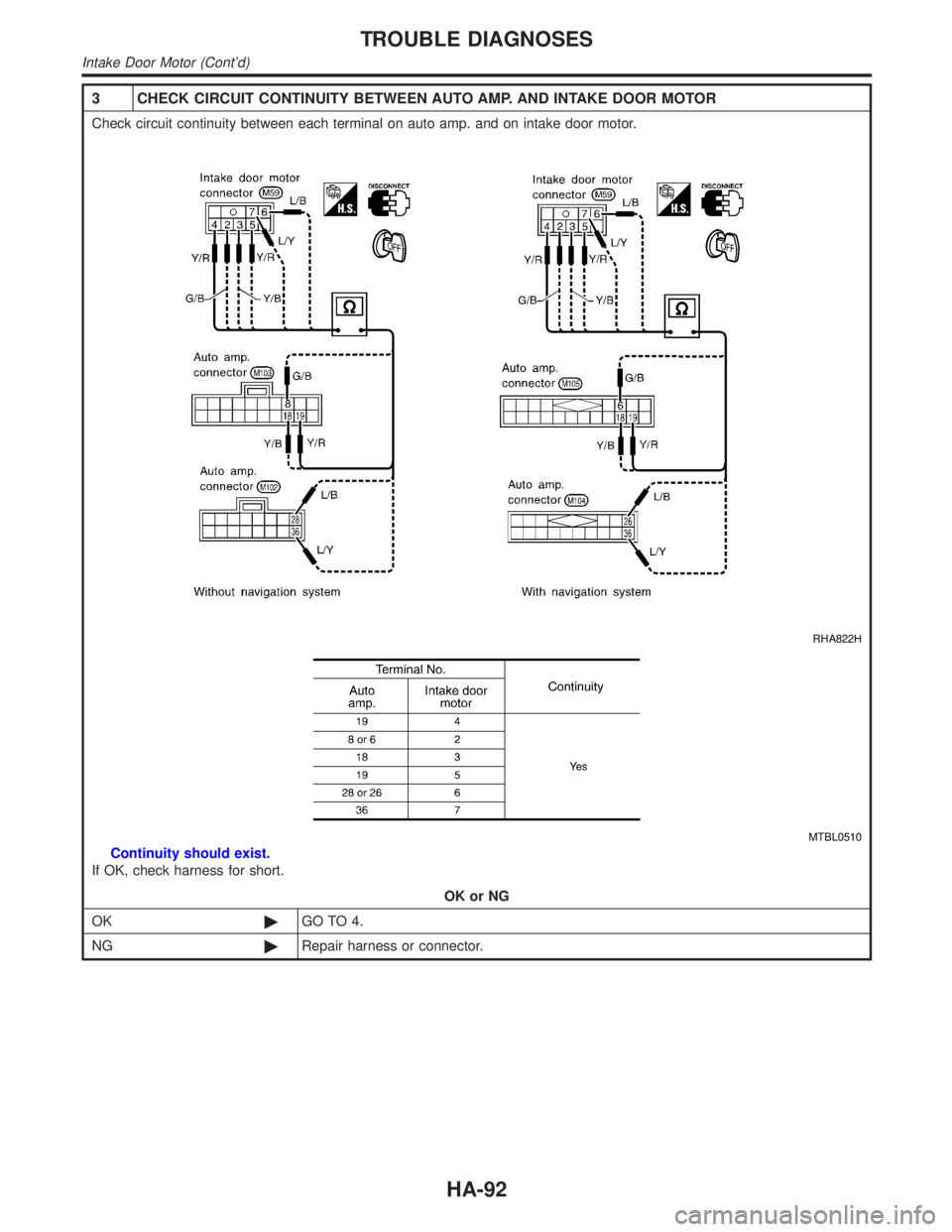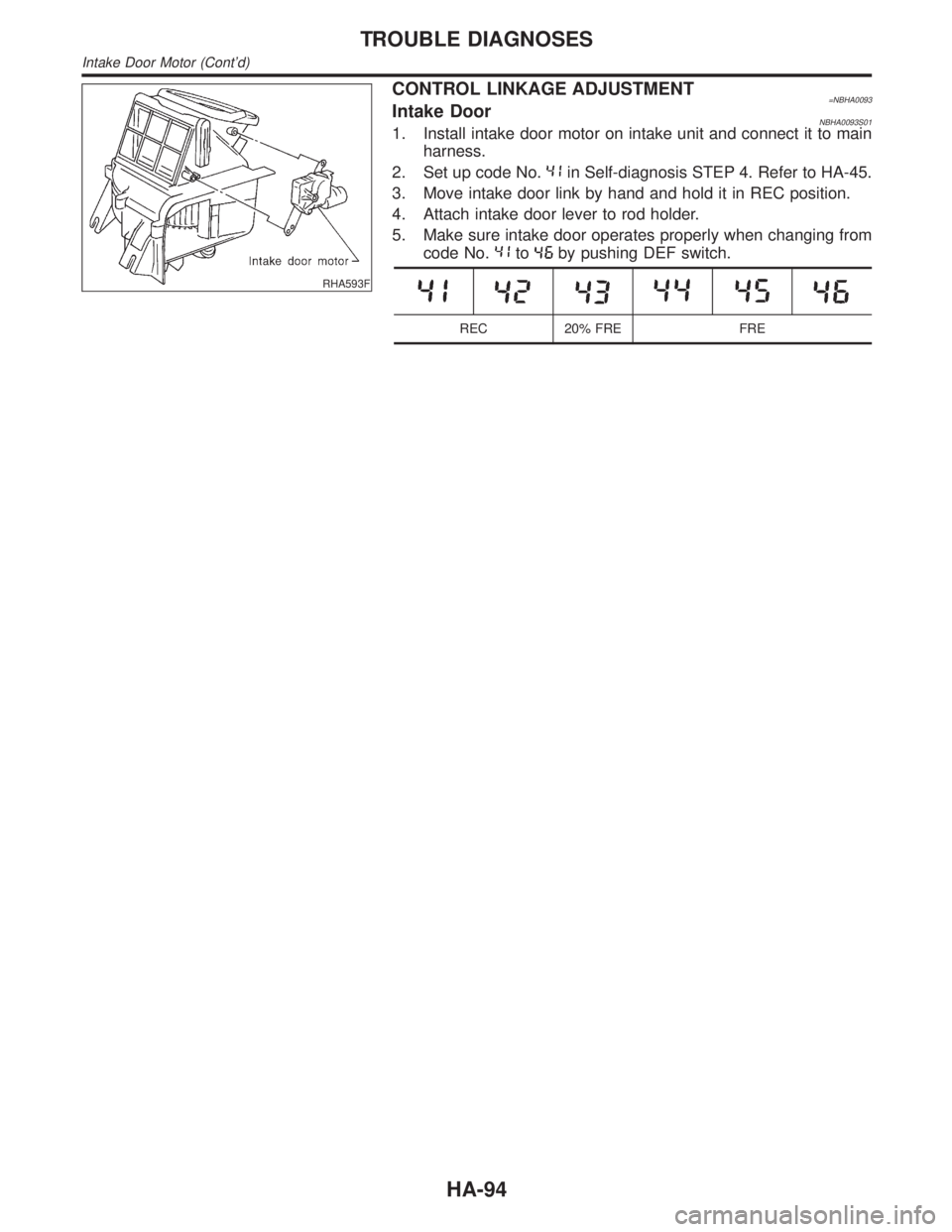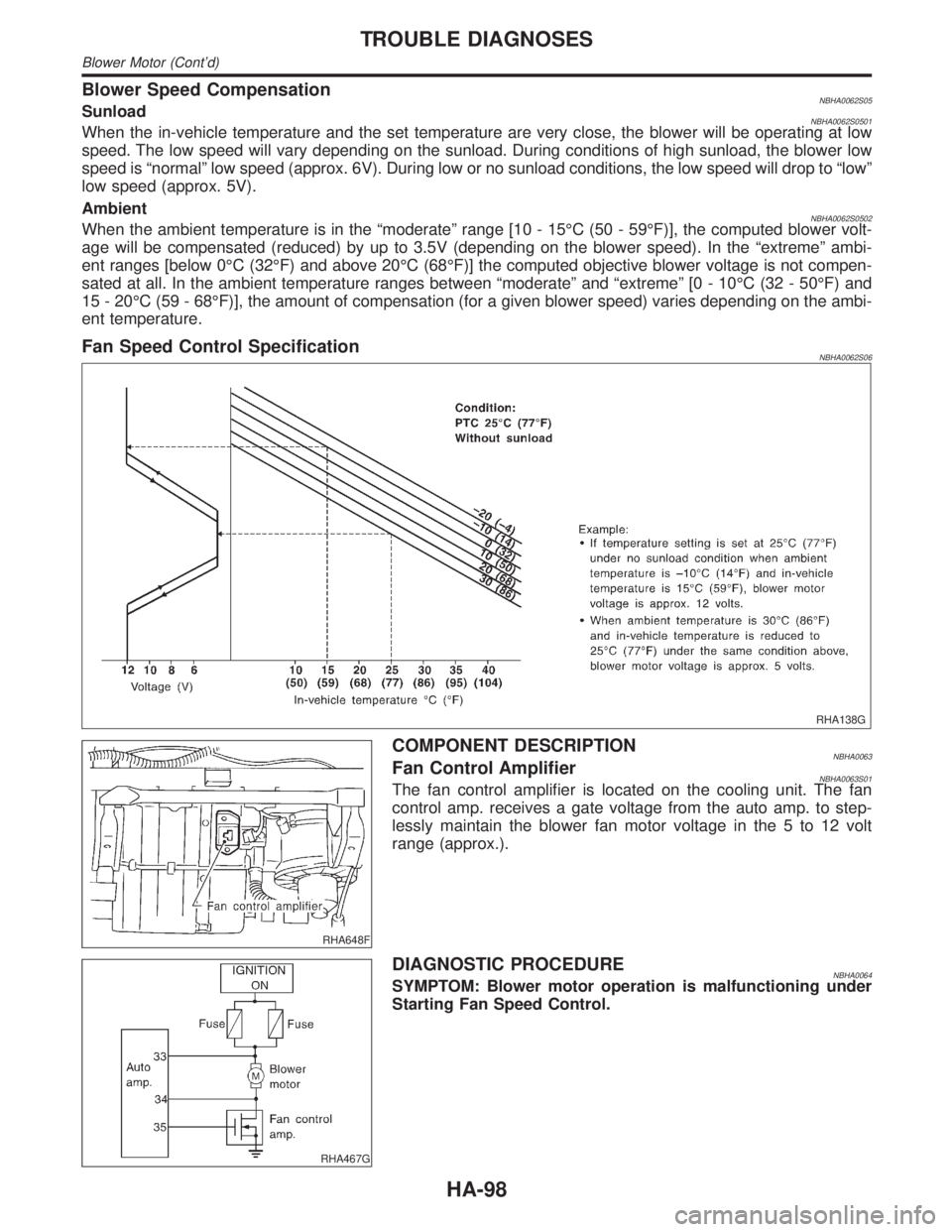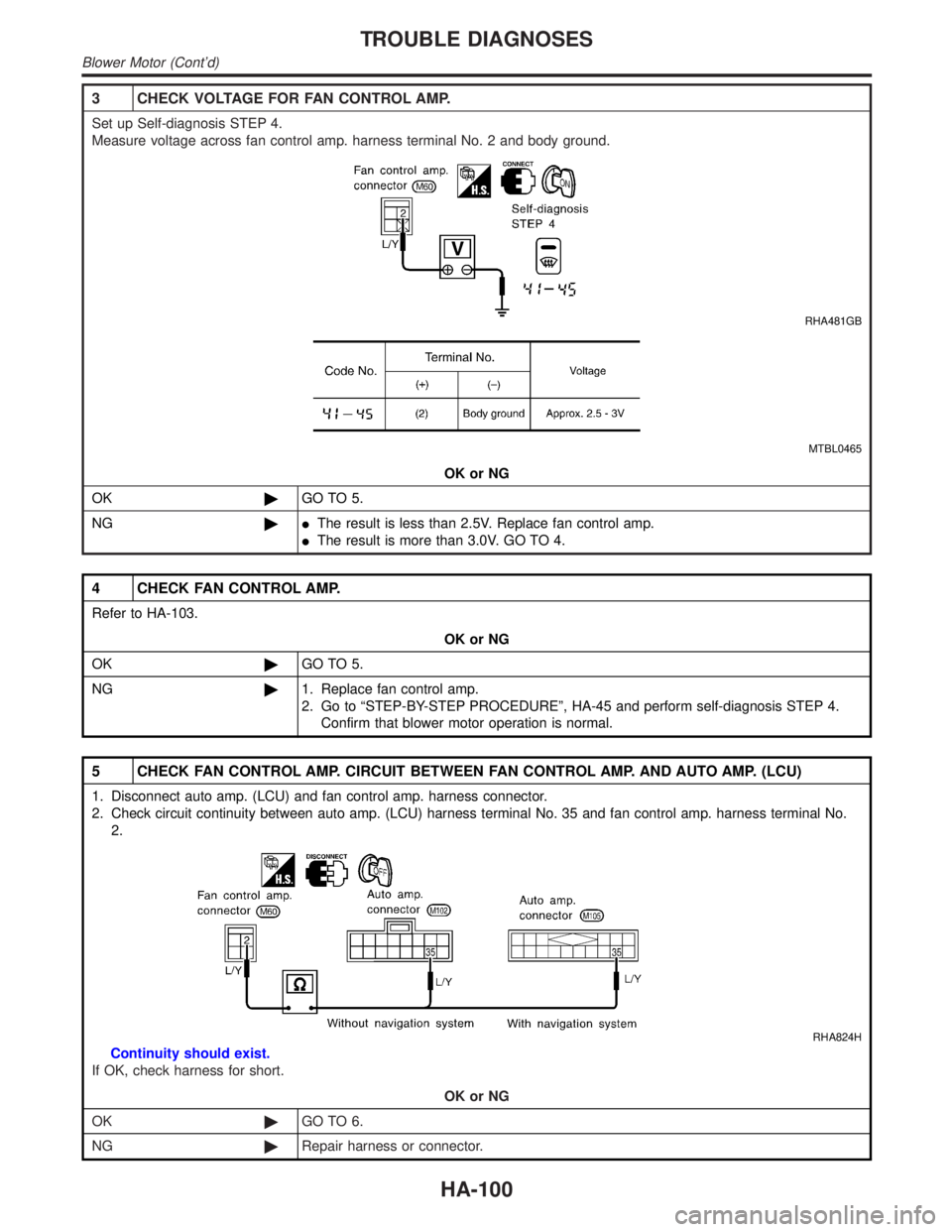INFINITI QX4 2001 Factory Service Manual
Manufacturer: INFINITI, Model Year: 2001, Model line: QX4, Model: INFINITI QX4 2001Pages: 2395, PDF Size: 43.2 MB
Page 1891 of 2395

3 CHECK CIRCUIT CONTINUITY BETWEEN AUTO AMP. AND INTAKE DOOR MOTOR
Check circuit continuity between each terminal on auto amp. and on intake door motor.
RHA822H
MTBL0510
Continuity should exist.
If OK, check harness for short.
OK or NG
OK©GO TO 4.
NG©Repair harness or connector.
TROUBLE DIAGNOSES
Intake Door Motor (Cont'd)
HA-92
Page 1892 of 2395

4 CHECK FOR AUTO AMP. OUTPUT
Set up Self-diagnosis STEP 4.
Measure voltage across auto amp. harness terminals and body ground.
RHA823H
MTBL0468
OK or NG
OK©Replace intake door motor.
NG©Replace auto amp.
GI
MA
EM
LC
EC
FE
AT
TF
PD
AX
SU
BR
ST
RS
BT
SC
EL
IDX
TROUBLE DIAGNOSES
Intake Door Motor (Cont'd)
HA-93
Page 1893 of 2395

RHA593F
CONTROL LINKAGE ADJUSTMENT=NBHA0093Intake DoorNBHA0093S011. Install intake door motor on intake unit and connect it to main
harness.
2. Set up code No.
in Self-diagnosis STEP 4. Refer to HA-45.
3. Move intake door link by hand and hold it in REC position.
4. Attach intake door lever to rod holder.
5. Make sure intake door operates properly when changing from
code No.
toby pushing DEF switch.
REC 20% FRE FRE
TROUBLE DIAGNOSES
Intake Door Motor (Cont'd)
HA-94
Page 1894 of 2395

Blower Motor
TROUBLE DIAGNOSIS PROCEDURE FOR BLOWER MOTOR=NBHA0094SYMPTOM:
IBlower motor operation is malfunctioning.
IBlower motor operation is malfunctioning under out of starting fan speed control.
Inspection FlowNBHA0094S01Without Navigation SystemNBHA0094S0101
SHA248FA
*1: HA-44
*2: HA-129
*3: HA-132
*4: HA-135
*5: HA-141*6: STEP-BY-STEP PROCEDURE
(HA-45), see No. 13.
*7: HA-98
*8: HA-98
*9: HA-45*10: HA-66
*11: HA-65
*12: HA-66
*13: HA-139
*14: EL-108
GI
MA
EM
LC
EC
FE
AT
TF
PD
AX
SU
BR
ST
RS
BT
SC
EL
IDX
TROUBLE DIAGNOSES
Blower Motor
HA-95
Page 1895 of 2395

With Navigation SystemNBHA0094S0102
RHA875H
*1: HA-44
*2: HA-129
*3: HA-132
*4: HA-135
*5: HA-141*6: STEP-BY-STEP PROCEDURE
(HA-45), see No. 13.
*7: HA-98
*8: HA-98
*9: HA-45*10: HA-66
*11: HA-65
*12: HA-66
*13: HA-139
*14: EL-108
TROUBLE DIAGNOSES
Blower Motor (Cont'd)
HA-96
Page 1896 of 2395

SYSTEM DESCRIPTION=NBHA0062Component partsNBHA0062S01Fan speed control system components are:
1) Auto amp.
2) Fan control amp.
3) A/C LAN system (PBR built-in mode door motor and air mix door motor)
4) In-vehicle sensor
5) Ambient sensor
6) Sunload sensor
7) Intake sensor
System OperationNBHA0062S02
SHA006FF
Automatic ModeNBHA0062S03In the automatic mode, the blower motor speed is calculated by the automatic amplifier based on inputs from
the PBR, in-vehicle sensor, sunload sensor, intake sensor and ambient sensor. The blower motor applied
voltage ranges from approximately 5 volts (lowest speed) to 12 volts (highest speed).
The control blower speed (in the range of 5 to 12V), the automatic amplifier supplies a gate voltage to the fan
control amplifier. Based on this voltage, the fan control amplifier controls the voltage supplied to the blower
motor.
Starting Fan Speed ControlNBHA0062S04Start Up From ªCOLD SOAKº Condition (Automatic mode)NBHA0062S0401In a cold start up condition where the engine coolant temperature is below 50ÉC (122ÉF), the blower will not
operate for a short period of time (up to 126 seconds). The exact start delay time varies depending on the
ambient and engine coolant temperature.
In the most extreme case (very low ambient) the blower starting delay will be 126 seconds as described above.
After this delay, the blower will operate at low speed until the engine coolant temperature rises above 55ÉC
(131ÉF), at which time the blower speed will increase to the objective speed.
Start Up From Normal or ªHOT SOAKº Condition (Automatic mode)
NBHA0062S0402The blower will begin operation momentarily after the AUTO button is pushed. The blower speed will gradu-
ally rise to the objective speed over a time period of 3 seconds or less (actual time depends on the objective
blower speed).
GI
MA
EM
LC
EC
FE
AT
TF
PD
AX
SU
BR
ST
RS
BT
SC
EL
IDX
TROUBLE DIAGNOSES
Blower Motor (Cont'd)
HA-97
Page 1897 of 2395

Blower Speed CompensationNBHA0062S05SunloadNBHA0062S0501When the in-vehicle temperature and the set temperature are very close, the blower will be operating at low
speed. The low speed will vary depending on the sunload. During conditions of high sunload, the blower low
speed is ªnormalº low speed (approx. 6V). During low or no sunload conditions, the low speed will drop to ªlowº
low speed (approx. 5V).
Ambient
NBHA0062S0502When the ambient temperature is in the ªmoderateº range [10 - 15ÉC (50 - 59ÉF)], the computed blower volt-
age will be compensated (reduced) by up to 3.5V (depending on the blower speed). In the ªextremeº ambi-
ent ranges [below 0ÉC (32ÉF) and above 20ÉC (68ÉF)] the computed objective blower voltage is not compen-
sated at all. In the ambient temperature ranges between ªmoderateº and ªextremeº [0 - 10ÉC (32 - 50ÉF) and
15 - 20ÉC (59 - 68ÉF)], the amount of compensation (for a given blower speed) varies depending on the ambi-
ent temperature.
Fan Speed Control SpecificationNBHA0062S06
RHA138G
RHA648F
COMPONENT DESCRIPTIONNBHA0063Fan Control AmplifierNBHA0063S01The fan control amplifier is located on the cooling unit. The fan
control amp. receives a gate voltage from the auto amp. to step-
lessly maintain the blower fan motor voltage in the 5 to 12 volt
range (approx.).
RHA467G
DIAGNOSTIC PROCEDURENBHA0064SYMPTOM: Blower motor operation is malfunctioning under
Starting Fan Speed Control.
TROUBLE DIAGNOSES
Blower Motor (Cont'd)
HA-98
Page 1898 of 2395

1 CHECK POWER SUPPLY FOR FAN CONTROL AMP.
Disconnect fan control amp. harness connector.
Do approx. 12 volts exist between fan control amp. harness terminal No. 3 and body ground?
RHA480G
YesorNo
Ye s©GO TO 2.
No©GO TO 8.
2 CHECK BODY GROUND CIRCUIT FOR FAN CONTROL AMP.
Does continuity exist between fan control amp. harness terminal No. 1 and body ground?
RHA089G
YesorNo
Ye s©Reconnect fan control amp. harness connector. And GO TO 3.
No©Repair harness or connector.
GI
MA
EM
LC
EC
FE
AT
TF
PD
AX
SU
BR
ST
RS
BT
SC
EL
IDX
TROUBLE DIAGNOSES
Blower Motor (Cont'd)
HA-99
Page 1899 of 2395

3 CHECK VOLTAGE FOR FAN CONTROL AMP.
Set up Self-diagnosis STEP 4.
Measure voltage across fan control amp. harness terminal No. 2 and body ground.
RHA481GB
MTBL0465
OK or NG
OK©GO TO 5.
NG©IThe result is less than 2.5V. Replace fan control amp.
IThe result is more than 3.0V. GO TO 4.
4 CHECK FAN CONTROL AMP.
Refer to HA-103.
OK or NG
OK©GO TO 5.
NG©1. Replace fan control amp.
2. Go to ªSTEP-BY-STEP PROCEDUREº, HA-45 and perform self-diagnosis STEP 4.
Confirm that blower motor operation is normal.
5 CHECK FAN CONTROL AMP. CIRCUIT BETWEEN FAN CONTROL AMP. AND AUTO AMP. (LCU)
1. Disconnect auto amp. (LCU) and fan control amp. harness connector.
2. Check circuit continuity between auto amp. (LCU) harness terminal No. 35 and fan control amp. harness terminal No.
2.
RHA824H
Continuity should exist.
If OK, check harness for short.
OK or NG
OK©GO TO 6.
NG©Repair harness or connector.
TROUBLE DIAGNOSES
Blower Motor (Cont'd)
HA-100
Page 1900 of 2395

6 CHECK FAN FEED BACK CIRCUIT
Reconnect auto amp. (LCU) harness connector.
Do approx. 12 volts exist between auto amp. (LCU) harness terminal No. 33 and body ground?
RHA825H
YesorNo
Ye s©GO TO 7.
No©Check power supply circuit and 15A fuses (Nos. 1 and 2, located in the fuse block).
Refer to EL-14, ªWiring Diagram Ð POWER к.
IIf OK, check for open circuit in wiring harness.
Repair or replace as necessary.
IIf NG, replace fuse and check wiring harness for short circuit.
Repair or replace as necessary.
7 CHECK POWER SUPPLY FOR AUTO AMP.
Do approx. 12 volts exist between auto amp. harness terminal No. 34 and body ground?
RHA826H
YesorNo
Ye s©1. Replace auto amp.
2. Go to self-diagnosis step-by-step procedure (HA-45) and perform self-diagnosis STEP
4.
Confirm that blower motor operation is normal.
No©GO TO 10.
GI
MA
EM
LC
EC
FE
AT
TF
PD
AX
SU
BR
ST
RS
BT
SC
EL
IDX
TROUBLE DIAGNOSES
Blower Motor (Cont'd)
HA-101